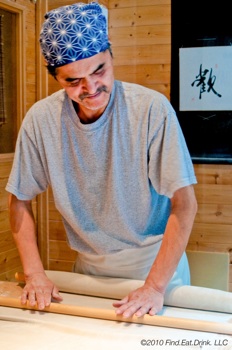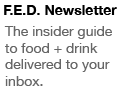Sobakoh | NYC
August 17, 2009
What
Japanese handmade soba noodles.
Why
Handmade soba noodles individually cut using a traditional soba kiri cleaver. Owner/artisan studied in Japan to become a soba master. Buckwheat lowers blood pressure, and decreases cholesterol.

A lot of restaurants boast about serving a homemade product, but Sobakoh goes the extra mile, they show you how they do it. In a glass booth facing East Fifth Street the owner, Hiromitsu Takahashi, masterfully rolls out fresh-made dough for Sobakoh’s noodles. It’s a genius piece of marketing. Once you stop to watch Takahashi’s mixture of theatrics, grace and athleticism, chances are you’ll want to go in and taste his creations.
Master Takahashi decided to study the craft of hand-making soba in Japan after working at several New York restaurants. All day long, he is in the glass booth rolling and cutting fresh noodles the old fashion way. No machine is ever used and each is hand-cut with a traditional soba kiri cleaver (“soba kiri” literally translates to “buckwheat noodle slice”).
The noodles are divine. They consist of 80 percent buckwheat (for flavor) and 20 percent flour (for texture). Served either hot or cold, they are silky and extra fine. Tempura eel, jumbo shrimp, and vegetables are just some of the combinations you can order to accompany your soba noodles, others include: sea urchin, salmon roe, soft-shell crab, three kinds of mushroom (shimeji, shiitake, enoki), grated Japanese yam with quail egg, and deep fried tofu. They also have deep-fried soba with sea salt (Age Soba) or fried soba gnocchi stuffed with ground chicken (Agedashi Sobagaki) as an appetizer.
Buckwheat is actually a fruit; it’s a dicot in the polygonaceae family, which also includes rhubarb and sorrel. The bonus of eating buckwheat soba, aside from the delight of slurping (even a proper Englishman was spotting making the slurp noise) is that it’s extremely healthy. Buckwheat contains choline, which is a compound in the vitamin B complex that plays an important role in metabolism, lowers blood pressure, and decreases cholesterol… nice, a noodle that actually reduces fat accumulation and is good for your heart. It also contains all eight essential amino acids, making it close to a “complete” protein, more so that any other plant source (including soy beans). They also have a selection of more than 15 different sakes. Sake is rich in amino acids, promoting good health and a rosy complexion.
For dessert, they offer vanilla or green tea ice cream, but most people order the black sesame pudding. Black sesame seeds are naturally sweet and the mild sweetness comes through in the thick, creamy pudding, which slightly resembles dark espresso, bitter chocolate, and coffee grounds in flavor and texture. Don’t let this description deter you; it’s worth a try.
There are only 26 seats at Sobakoh, most occupied by a predominately Japanese crowd. Making a reservation is recommended. The decor is simple and elegant. A Nakashima-style wooden bar with six seats on one side of the room, tables and a long bench on the other. They do have an early bird tasting special from 5:30pm - 7pm. Avoid going too late at night, since the soba may not be as fresh.

Japanese
East Village
309 East 5th Street
New York, NY 10003 (view map)
T: 212-254-2244
Hours:
Mon - Thu: 5:30pm - 11pm
Fri - Sun: 12pm - 3pm, 5:30pm - 11pm


Hiromutsu Takahashi’s recommendations on where he likes to eat Japanese cuisine in New York.
RECOMMENDATIONS





Watch the video Hiromitsu Takahashi make soba noodles to the music of Moby.
VIDEO

East Village - New York, NY









Article


















